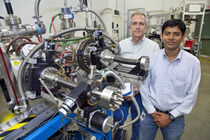


The Environmental Energy Technologies Division has received $7.15 million in American Recovery and Reinvestment Act funding for four projects to support residential energy retrofits. The funding comes from DOE’s Building Technologies Program, which has the goal of retrofitting five to 10 million homes by 2012. Energy retrofits are considered to be among the most cost effective ways for the nation to reduce its energy use and carbon emissions.
The four projects are:
- Retrofit analysis of multifamily homes, $250,000, lead PI: Bill Fisk
-
Retrofit research, quality management, and technical support, $1.4 million, Iain Walker
-
Retrofit marketing and behavioral research, $2.5 million, Rick Diamond
-
Home rating and labeling support (Home Energy Saver), $3 million, Evan Mills
Berkeley Lab has been awarded more than $300 million in Recovery Act funding. More>
 While those wonderful light sabers in the Star Wars films remain the figment of George Lucas’s fertile imagination, light mills—rotary motors driven by light—that can power objects thousands of times greater in size are now fact. Xiang Zhang of the Materials Sciences Division, working with Ming Liu, Thomas Zentgraf, Yongmin Liu, and Guy Bartal, has created the first nano-sized light mill whose rotational speed and direction can be controlled by tuning the frequency of the incident light waves. It may not help conquer the Dark Side, but this new light mill should open the door to a broad range of valuable applications, including a new generation of nanoelectromechanical systems, nanoscale solar light harvesters, and bots that can perform in vivo manipulations of DNA and other biological molecules. More>
While those wonderful light sabers in the Star Wars films remain the figment of George Lucas’s fertile imagination, light mills—rotary motors driven by light—that can power objects thousands of times greater in size are now fact. Xiang Zhang of the Materials Sciences Division, working with Ming Liu, Thomas Zentgraf, Yongmin Liu, and Guy Bartal, has created the first nano-sized light mill whose rotational speed and direction can be controlled by tuning the frequency of the incident light waves. It may not help conquer the Dark Side, but this new light mill should open the door to a broad range of valuable applications, including a new generation of nanoelectromechanical systems, nanoscale solar light harvesters, and bots that can perform in vivo manipulations of DNA and other biological molecules. More>
 Forget the magnets on your fridge. How about a magnet in your fridge, one that keeps your leftover pizza cold while consuming less energy than today’s refrigerators? It could happen. But scientists must first gain a better understanding of a phenomenon called the giant magnetocaloric effect, in which a changing magnetic field in a material causes its temperature to drop precipitously. “It’s a very promising concept. But to make it a reality, we first must learn in detail what’s happening inside materials as they undergo the giant magnetocaloric effect,” says physicist Sujoy Roy (right), who is working on the project with Jeff Kortright (left) of the Materials Sciences Division. More>
Forget the magnets on your fridge. How about a magnet in your fridge, one that keeps your leftover pizza cold while consuming less energy than today’s refrigerators? It could happen. But scientists must first gain a better understanding of a phenomenon called the giant magnetocaloric effect, in which a changing magnetic field in a material causes its temperature to drop precipitously. “It’s a very promising concept. But to make it a reality, we first must learn in detail what’s happening inside materials as they undergo the giant magnetocaloric effect,” says physicist Sujoy Roy (right), who is working on the project with Jeff Kortright (left) of the Materials Sciences Division. More>
 [Innovation] Berkeley Lab’s Jay Keasling and the Joint BioEnergy Institute (JBEI), the partnership for which the Lab is the lead member, are featured in the new issue of Innovation: America's Journal of Technology Commercialization. The story is titled “Making Biofuels a Reality” and covers everything from the JBEI mission to Keasling’s appearance on the Colbert Report. Innovation, which in its previous issue featured a profile on Lab Director Paul Alivisatos, is a bimonthly publication sponsored by the Technology Ventures Corporation in partnership with the U.S. Department of Energy.
[Innovation] Berkeley Lab’s Jay Keasling and the Joint BioEnergy Institute (JBEI), the partnership for which the Lab is the lead member, are featured in the new issue of Innovation: America's Journal of Technology Commercialization. The story is titled “Making Biofuels a Reality” and covers everything from the JBEI mission to Keasling’s appearance on the Colbert Report. Innovation, which in its previous issue featured a profile on Lab Director Paul Alivisatos, is a bimonthly publication sponsored by the Technology Ventures Corporation in partnership with the U.S. Department of Energy.
 [liveMint.com, Wall Street Journal] Since the Large Hadron Collider restarted in February, science buffs have been waiting for indicators that the megamachine is getting closer to solving the mysteries of the universe. At last week’s annual Nobel Laureate Meeting in Lindau, Germany, six Nobelists in particle physics and cosmology agreed to disagree about their expectations. The Physics Division’s George Smoot summed up the debate: the universe is “a key lab for studies of new fundamental physics,” he said, but “we shouldn’t lose sight of the fact that [the LHC] is our Columbus and we’ve been sailing for 50 years.” More>
[liveMint.com, Wall Street Journal] Since the Large Hadron Collider restarted in February, science buffs have been waiting for indicators that the megamachine is getting closer to solving the mysteries of the universe. At last week’s annual Nobel Laureate Meeting in Lindau, Germany, six Nobelists in particle physics and cosmology agreed to disagree about their expectations. The Physics Division’s George Smoot summed up the debate: the universe is “a key lab for studies of new fundamental physics,” he said, but “we shouldn’t lose sight of the fact that [the LHC] is our Columbus and we’ve been sailing for 50 years.” More>

After nearly 40 years with the University of California and Berkeley Lab, Principal Resource Analyst Wendell Hom has retired. He started at UC Berkeley as a student employee in 1969 and became a fulltime employee in 1972, working with the Electrical Engineering & Computer Sciences and Electronics Research Lab departments. In 1980, he joined Berkeley Lab’s Life Sciences Division (then known as the Biology and Medicine Division) and, aside from two years with Loma Linda University Medical Center, has been with Berkeley Lab ever since. Watch him recount stories of his dozen years with the JGI on the JGI Facebook page.
Two more sessions of IT's "Introduction to Google Calendar" have been scheduled for Wednesday in the Building 50 Auditorium at 9:30 to 10:30 a.m. and 1:30 to 2:30 p.m. Attendance is encouraged to help prepare for the migration during the weekend of July 31. The lecture will cover the basics: navigation, meeting management, adding and using secondary calendars as well as viewing co-worker and resource calendars. IT has also completed its final test run, migrating data from Oracle Calendar to a test area. Go to gcal.gtest2.lbl.gov and view your calendar with data as of June 30. If you do, please take a few minutes to complete this short survey. For more information about Google Calendar go here.
Today
at Berkeley Lab encourages feedback and story ideas
Deadline for submissions is 10 a.m. two days prior to publication
TABL is produced by Public Affairs' Communications Group